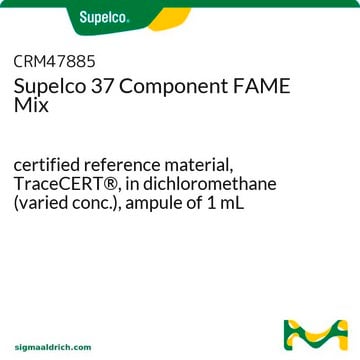33033
Boron trichloride - Methanol
12 % (w/w), pkg of 400 mL
Synonym(s):
BCl3
About This Item
Recommended Products
reaction suitability
reagent type: derivatization reagent
reaction type: Esterifications
packaging
pkg of 400 mL
concentration
12 % (w/w)
storage temp.
2-8°C
Looking for similar products? Visit Product Comparison Guide
General description
Application
Other Notes
related product
Signal Word
Danger
Hazard Statements
Precautionary Statements
Hazard Classifications
Acute Tox. 2 Oral - Acute Tox. 3 Dermal - Acute Tox. 3 Inhalation - Eye Dam. 1 - Flam. Liq. 2 - Repr. 1B - Skin Corr. 1B - STOT SE 1
Target Organs
Eyes,Central nervous system
Supplementary Hazards
Storage Class Code
3 - Flammable liquids
WGK
WGK 3
Flash Point(F)
51.8 °F - closed cup
Flash Point(C)
11 °C - closed cup
Choose from one of the most recent versions:
Already Own This Product?
Find documentation for the products that you have recently purchased in the Document Library.
Customers Also Viewed
Active Filters
Our team of scientists has experience in all areas of research including Life Science, Material Science, Chemical Synthesis, Chromatography, Analytical and many others.
Contact Technical Service








